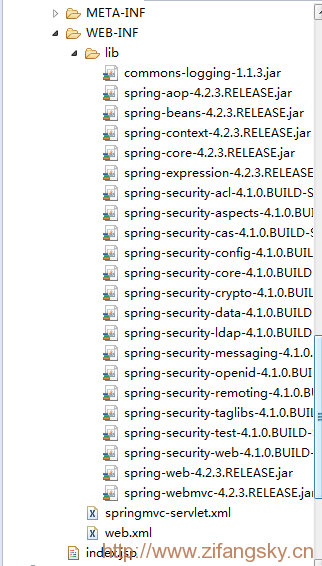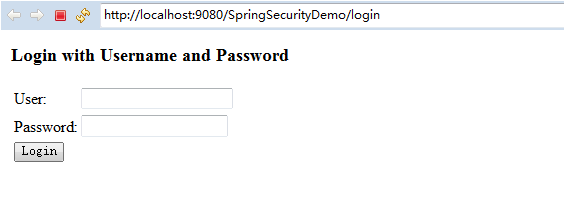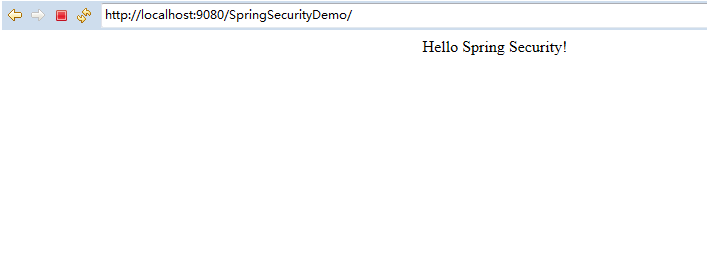一 简介
Spring Security是为基于Spring的应用程序提供的一种声明式安全性框架。它提供了一套完整的安全性解决方案,能够在Web请求级别和方法调用级别处理身份认证和授权。
Spring Security可以从两个方面来解决安全性问题:
-
使用Servlet规范中的Filter保护Web请求并限制URL级别的访问
-
使用Spring AOP保护方法调用——借助于对象代理和使用通知,能够确保只有具备适当权限的用户才能方法安全保护的方法
下面我将简单介绍Spring Security的最基础的入门实例
二 Spring Security入门实例
(1)新建基于Spring MVC的Java Web项目:
导入Spring Security以及一些其他的spring相关的包之后,项目结构如下所示:
在这个测试项目中不需要再另写Java文件,同时也不涉及到数据库操作,实际上涉及到的文件只有:index.jsp、web.xml以及springmvc-servlet.xml文件
(2)web.xml:
|
1
2
3
4
5
6
7
8
9
10
11
12
13
14
15
16
17
18
19
20
21
22
23
24
25
26
27
28
29
30
31
32
33
34
35
36
37
38
39
40
41
42
43
44
45
46
47
48
|
<?
xml
version
=
"1.0"
encoding
=
"UTF-8"
?>
<
web-app
xmlns:xsi
=
"http://www.w3.org/2001/XMLSchema-instance"
xmlns
=
"http://java.sun.com/xml/ns/javaee"
xsi:schemaLocation
=
"http://java.sun.com/xml/ns/javaee http://java.sun.com/xml/ns/javaee/web-app_3_0.xsd"
version
=
"3.0"
>
<
servlet
>
<
servlet-name
>springmvc</
servlet-name
>
<
servlet-class
>org.springframework.web.servlet.DispatcherServlet</
servlet-class
>
<
load-on-startup
>1</
load-on-startup
>
</
servlet
>
<
servlet-mapping
>
<
servlet-name
>springmvc</
servlet-name
>
<
url-pattern
>*.html</
url-pattern
>
</
servlet-mapping
>
<
filter
>
<
filter-name
>characterEncodingFilter</
filter-name
>
<
filter-class
>org.springframework.web.filter.CharacterEncodingFilter</
filter-class
>
<
init-param
>
<
param-name
>encoding</
param-name
>
<
param-value
>UTF-8</
param-value
>
</
init-param
>
</
filter
>
<
filter-mapping
>
<
filter-name
>characterEncodingFilter</
filter-name
>
<
url-pattern
>/*</
url-pattern
>
</
filter-mapping
>
<
filter
>
<
filter-name
>springSecurityFilterChain</
filter-name
>
<
filter-class
>org.springframework.web.filter.DelegatingFilterProxy</
filter-class
>
</
filter
>
<
filter-mapping
>
<
filter-name
>springSecurityFilterChain</
filter-name
>
<
url-pattern
>/*</
url-pattern
>
</
filter-mapping
>
<
welcome-file-list
>
<
welcome-file
>index.html</
welcome-file
>
<
welcome-file
>index.htm</
welcome-file
>
<
welcome-file
>index.jsp</
welcome-file
>
<
welcome-file
>default.html</
welcome-file
>
<
welcome-file
>default.htm</
welcome-file
>
<
welcome-file
>default.jsp</
welcome-file
>
</
welcome-file-list
>
</
web-app
>
|
在这个web.xml中,除了定义的一些常规的Spring项目的配置之外,在文件的第30-38行定义了一个名为“springSecurityFilterChain”的filter,这个filter定义之后spring security保护web请求这个作用就开始生效了,spring security将会对请求的url进行拦截并判断其权限
(3)springmvc-servlet.xml:
|
1
2
3
4
5
6
7
8
9
10
11
12
13
14
15
16
17
18
19
20
21
22
23
24
25
26
27
28
29
30
31
32
33
34
35
36
37
38
39
40
41
42
43
44
|
<?
xml
version
=
"1.0"
encoding
=
"UTF-8"
?>
<
beans
xmlns
=
"http://www.springframework.org/schema/beans"
xmlns:xsi
=
"http://www.w3.org/2001/XMLSchema-instance"
xmlns:context
=
"http://www.springframework.org/schema/context"
xmlns:security
=
"http://www.springframework.org/schema/security"
xmlns:mvc
=
"http://www.springframework.org/schema/mvc"
xsi:schemaLocation="http://www.springframework.org/schema/beans
http://www.springframework.org/schema/beans/spring-beans-4.0.xsd
http://www.springframework.org/schema/context
http://www.springframework.org/schema/context/spring-context-4.0.xsd
http://www.springframework.org/schema/mvc
http://www.springframework.org/schema/mvc/spring-mvc-4.0.xsd
http://www.springframework.org/schema/security
http://www.springframework.org/schema/security/spring-security-4.1.xsd">
<
security:user-service
id
=
"userService"
>
<
security:user
name
=
"admin"
password
=
"admin"
authorities
=
"ROLE_USER,ROLE_ADMIN"
/>
<
security:user
name
=
"zifangsky"
password
=
"www.zifangsky.cn"
authorities
=
"ROLE_USER"
/>
</
security:user-service
>
<
security:authentication-manager
>
<
security:authentication-provider
user-service-ref
=
"userService"
/>
</
security:authentication-manager
>
<
security:http
pattern
=
"/favicon.ico"
security
=
"none"
/>
<
security:http
auto-config
=
"true"
>
<
security:intercept-url
pattern
=
"/**"
access
=
"hasRole('ROLE_USER')"
/>
</
security:http
>
<
context:component-scan
base-package
=
"cn.zifangsky.* *.controller"
/>
<
context:annotation-config
/>
<!-- 激活Bean中定义的注解 -->
<
mvc:annotation-driven
/>
<
bean
class
=
"org.springframework.web.servlet.view.InternalResourceViewResolver"
>
<
property
name
=
"prefix"
value
=
"/WEB-INF/pages/"
/>
<
property
name
=
"suffix"
value
=
".jsp"
/>
</
bean
>
</
beans
>
|
在这个配置文件中,实际上34行及之后的那些配置都是跟SpringMVC相关的,而之前的那些配置则是在定义spring security的权限校验规则。
在第29-32行的配置中,“http”定义了一个Web相关的权限配置,同时“intercept-url”标签则配置了权限控制规则,即:网站根目录下的所有目录都需要有“ROLE_USER”的权限才允许访问。这将导致我们在访问首页的index.jsp文件都需要进行权限验证,也就是说程序运行之后就需要登录验证,验证通过之后才能访问首页及其他页面。当然,这个登录页面是spring security默认自带的,我在后面的文章中再说如何进行自定义这个登录页面
既然spring security需要验证访客的身份,那么就需要我们提供哪些用户具有哪些访问权限,也就是第22-25行配置的“authentication-manager”了,当然真正进行身份验证的是“authentication-provider”这个元素,从上面代码可以看出这里只是简单引用了一个采用硬编码的“user-service”,其里面定义了两个角色以及它们所对应的权限。
注:真正生产环境中,用户及其对应的权限这些信息是需要从数据库中读取的,这里为了理解方便就这样硬编码了
(4)index.jsp:
|
1
2
3
4
5
6
7
8
9
10
11
12
13
14
15
16
17
18
19
|
<%@ page language="java" contentType="text/html; charset=UTF-8"
pageEncoding="UTF-8"%>
<%
String path = request.getContextPath();
String basePath = request.getScheme()+"://"+request.getServerName()+":"+request.getServerPort()+path+"/";
%>
<!DOCTYPE html>
<
html
>
<
head
>
<
meta
http-equiv
=
"Content-Type"
content
=
"text/html; charset=UTF-8"
>
<
base
href="<%=basePath%>">
<
title
>Spring Security Demo</
title
>
</
head
>
<
body
>
<
div
align
=
"center"
>
Hello Spring Security!
</
div
>
</
body
>
</
html
>
|
(5)运行测试:
运行项目之后,我们可以发现并没有直接出现首页,而是强制转到了一个默认的登录页面:
然后输入上面定义的两组用户认证的其中一个,比如:admin/admin,然后就可以跳转到正常的首页中去了:
至此,这个最基本的spring security入门实例到此就结束了。不过我将在后面的文章中进一步说明spring security的其他用法
本文转自 pangfc 51CTO博客,原文链接:http://blog.51cto.com/983836259/1853887,如需转载请自行联系原作者




 本文介绍SpringSecurity的基础使用方法,包括如何在SpringMVC项目中配置权限控制,实现基于角色的访问验证。通过一个简单的示例项目,展示了如何设置登录认证流程。
本文介绍SpringSecurity的基础使用方法,包括如何在SpringMVC项目中配置权限控制,实现基于角色的访问验证。通过一个简单的示例项目,展示了如何设置登录认证流程。




















 被折叠的 条评论
为什么被折叠?
被折叠的 条评论
为什么被折叠?








